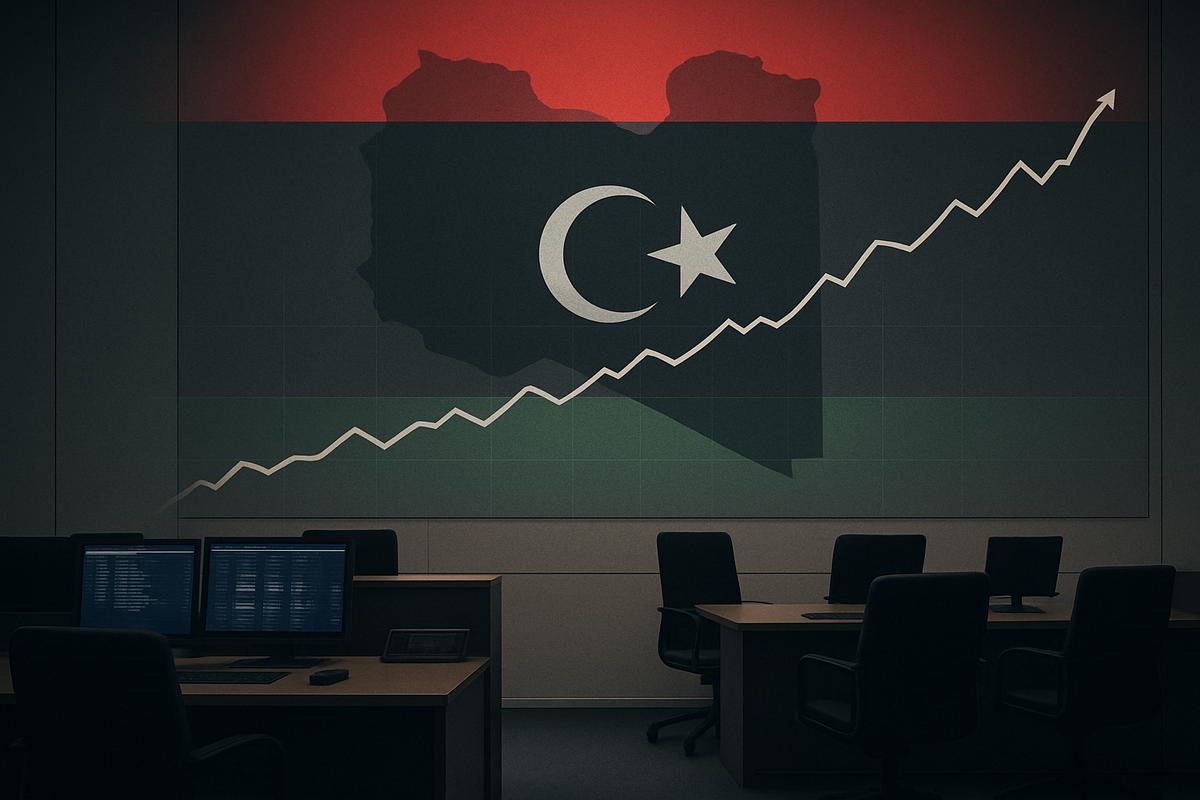
Tripoli, Libya – October 10, 2025 – The Libyan Stock Market (LSM) concluded its weekly trading sessions on a note of stability, with its general index holding steady at 1,066.00 points. This consistent performance, however, belies a persistent challenge: remarkably low trading activity. Despite the index's resilience, the market witnessed a mere six transactions throughout the week, underscoring a cautious investor sentiment and a capital market still grappling with significant structural limitations.
The market's performance this week epitomizes a broader trend observed in Libya's financial landscape. While the stability of the general index offers a semblance of normalcy, the near-stagnant trading volumes highlight the profound impact of the nation's complex economic and political environment. This dichotomy presents a unique scenario for investors and observers, where the market's underlying stability is overshadowed by a severe lack of liquidity and participation, pointing to deeper systemic issues that continue to restrain its growth and potential.
A Week of Stagnation: Details from the Libyan Bourse
The week ending October 10, 2025, saw the Libyan Stock Market's general index maintain its position at 1,066.00 points, mirroring its previous closing and indicating no significant upward or downward movement. This stability, while positive on the surface, was achieved on the back of extremely limited activity. A mere six transactions were executed across only two listed companies, totaling a paltry 46,636.000 Libyan dinars in value. The banking sector, a traditional cornerstone of the Libyan economy, saw the most activity, with Jumhouria Bank (LSM: JMB) accounting for four of these transactions. Conversely, the insurance sector recorded no trading activity whatsoever, further emphasizing the concentrated and narrow nature of the market's participation.
This week's performance is not an isolated incident but rather a continuation of a trend observed throughout recent months. For instance, on October 4, 2025, the market saw a slightly higher, though still modest, 28 transactions across four listed companies, with a total value of 792,863.760 Libyan dinars. Even in mid-September, reports indicated a total trading value of approximately 945,000 Libyan dinars, again dominated by a handful of deals in the banking sector. The Libyan Stock Market itself only reopened in 2023 after a nine-year hiatus, a testament to the prolonged periods of instability that have plagued the nation's financial infrastructure. This recent reopening, while a positive step, has yet to translate into robust trading volumes or a significant expansion of listed entities.
The broader timeline leading to this moment reveals a market striving for relevance in a challenging environment. Libya's economy, heavily reliant on its oil and gas sector, has been a victim of persistent political instability, a cumbersome bureaucracy, and issues of corruption. These factors collectively undermine investor confidence and deter both domestic and international participation in the stock market. The market’s current state reflects an ongoing struggle to attract capital and diversify beyond a very limited number of active players, primarily within the banking sector.
Companies Navigating a Constrained Market
In a market characterized by stable indices but extremely low trading volumes, the impact on listed companies is multifaceted. For entities like Jumhouria Bank (LSM: JMB), which saw the majority of the week's transactions, the limited activity means that price discovery can be slow, and liquidity for shareholders is severely restricted. While the stability of the index might suggest a healthy underlying valuation, the inability to easily buy or sell shares at scale can hinder capital raising efforts and deter new investors. Companies with higher trading volumes typically benefit from greater visibility and a more efficient mechanism for valuing their equity.
Other companies listed on the Libyan Stock Market, particularly those outside the banking sector, face even greater challenges. The complete absence of trading in the insurance sector this past week, for example, highlights a significant lack of investor interest or available capital for these segments. This can impede their ability to grow, expand operations, or attract new investment, as their shares remain largely illiquid. Publicly listed companies in such an environment might find it difficult to leverage their public status for capital formation, relying instead on private financing or retained earnings.
The lack of diversification in trading activity means that the market's performance is disproportionately influenced by a very small number of companies, predominantly banks. This concentration poses a risk, as the fortunes of the entire market become heavily tied to the performance and stability of these few dominant players. While these companies might benefit from less scrutiny due to low trading, they also miss out on the potential for enhanced corporate governance, increased public profile, and easier access to capital that a more active and liquid stock market provides. The current environment necessitates a focus on fundamental strength and operational efficiency for survival, rather than relying on market-driven growth.
Broader Significance and Economic Undercurrents
The Libyan Stock Market's current state of stable indices amidst limited trading activity is deeply intertwined with broader economic and political currents shaping the nation. This situation fits into a larger narrative of a resource-rich country struggling to translate its hydrocarbon wealth into diversified economic growth and robust financial institutions. The market's performance reflects the ongoing challenges of political fragmentation, weak institutional capacity, and a business environment still perceived as high-risk by many investors.
The International Monetary Fund (IMF) in its May 2025 Article IV Consultation, projected real GDP growth for Libya to increase to 7.7% in 2025, up from 2% in 2024. While non-hydrocarbon growth showed resilience, the IMF explicitly highlighted that "political instability and weak institutions continue to undermine public confidence in the banking sector." This directly impacts the stock market, as a lack of confidence in the banking sector – which dominates LSM trading – directly translates to a hesitant investor base. Similarly, the Arab Monetary Fund (AMF) projected a robust 14.3% economic expansion for Libya in 2025, largely contingent on improved domestic stability and investor confidence, primarily driven by the hydrocarbons sector. However, the AMF also cautioned that "weak institutional capacity and fragile stability impede structural transformation."
The ripple effects extend to international trade as well. The 21% decline in trade between Libya and Italy in the first half of 2025, primarily due to a drop in Libyan crude oil exports, underscores the volatility in Libya's primary revenue stream. This directly impacts government revenues and overall economic stability, which in turn influences the capital markets. Historically, markets in post-conflict or politically unstable regions often exhibit similar characteristics: periods of index stability punctuated by low volumes, as investors remain on the sidelines awaiting clearer political and economic signals. The Libyan Stock Market's nine-year closure preceding its 2023 reopening serves as a stark historical precedent of the fragility that can afflict capital markets in such environments.
What Comes Next: Pathways to Growth and Challenges Ahead
Looking ahead, the Libyan Stock Market faces a critical juncture. Short-term possibilities suggest a continuation of the current trend unless significant catalysts emerge. The Central Bank of Libya's (CBL) recent announcement regarding plans to issue unrestricted "Mudarabah" certificates to diversify sources of return for commercial banks offers a glimmer of hope. This initiative aims to expand the investment base and utilize available liquidity in the local market, potentially injecting much-needed capital and new instruments into the financial system, which could indirectly stimulate stock market activity. However, the immediate impact on trading volumes on the LSM remains to be seen.
In the long term, the market's trajectory will largely depend on the broader political and economic stability of Libya. Sustained peace, a unified government, and concrete reforms to improve the ease of doing business and combat corruption are essential. These factors are crucial for attracting both domestic and foreign direct investment, which could then translate into more listings and increased trading participation on the stock market. Potential strategic pivots for the LSM itself might include efforts to encourage more companies to list, particularly from the non-hydrocarbon sectors, and to enhance market infrastructure to improve transparency and accessibility for investors.
Market opportunities could emerge for early investors willing to take on higher risk in anticipation of future stability and growth. If Libya successfully diversifies its economy beyond oil and gas, or if political reconciliation leads to a surge in infrastructure development, the currently undervalued or illiquid stocks could see significant appreciation. Conversely, the challenges are substantial: continued political deadlock, persistent security issues, and a lack of robust regulatory frameworks could perpetuate the current state of limited activity, hindering the market's evolution into a viable capital-raising platform. Scenarios range from a gradual, albeit slow, increase in market sophistication driven by CBL initiatives, to a prolonged period of stagnation if underlying political and economic issues remain unaddressed.
A Cautious Outlook for Libya's Capital Market
The Libyan Stock Market's current performance, marked by stable indices but critically low trading volumes, paints a clear picture of a capital market in nascent stages of recovery, yet heavily constrained by broader national challenges. The key takeaway is a market that, while not experiencing significant declines, is also failing to generate the liquidity and participation necessary for robust growth and efficient capital allocation. The stability of the general index offers a reassuring facade, but the underlying anemic trading activity reveals a market struggling to fulfill its potential as a driver of economic development.
Moving forward, the market's health will be intrinsically linked to Libya's progress on political stability and economic diversification. While initiatives from the Central Bank of Libya to introduce new financial instruments are positive steps, their ultimate impact on stock market vibrancy will depend on the broader investor confidence and regulatory environment. The current reliance on the banking sector for what little trading occurs underscores the urgent need for market diversification and the listing of more companies from various sectors of the economy.
Investors should watch for concrete developments in Libya's political landscape, particularly any moves towards a unified and stable government, as well as reforms aimed at improving the business climate. Indicators such as increased foreign investment, diversification of the national economy beyond oil, and a rise in new company listings on the LSM would signal a positive shift. Until then, the Libyan Stock Market remains a testament to resilience in the face of adversity, but one that offers limited opportunities for active trading and significant capital appreciation in the short term. Its journey towards becoming a dynamic financial hub is long and fraught with both potential and peril.
This content is intended for informational purposes only and is not financial advice






